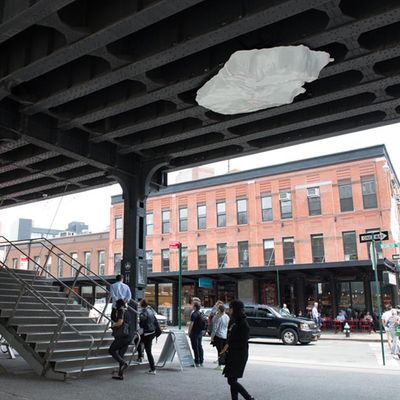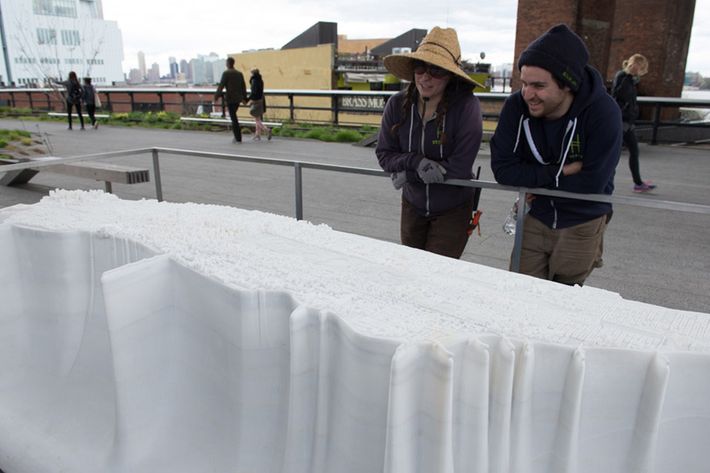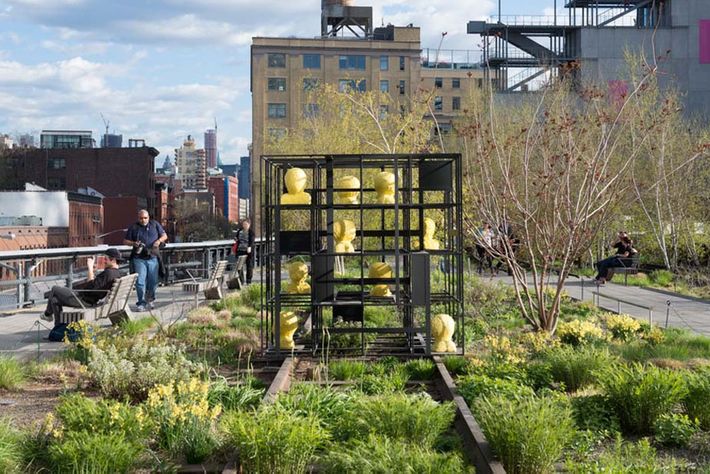
Now that summerÔÇÖs here, school is getting out, and temperatures have finally topped 80 degrees in New York, one thing is inevitable: Tourists are about to flock to the High Line in hordes. But there are some appealing things to see from the High Line, and weÔÇÖre not (just) talking about exhibitionist hanky-panky in the Standard Hotel. WeÔÇÖre talking about the extensive, expertly curated group of works part of High Line Art, the initiative that commissions pieces specifically for the elevated park, and switches up the roster of artists each season.
It makes for some lovely things to look at while dodging taco stands and lost French people.
Olafur EliassonÔÇÖs The collectivity project invites visitors to play with the big pile of Lego blocks heÔÇÖs left out on the High Line, hoping they can create a fantastical future skyline, perhaps one akin to the actual future skyline of Hudson Yards thatÔÇÖs currently growing behind the installation. Adri├ín Villar Rojas┬áhas a work where heÔÇÖs planted seeds into the still-fertile vegetation, and smashed some Nikes into a bed of rocks. Ryan Gander made a sculpture of his wife spitting out water ÔÇö he invites people to drink from it and essentially make out with her, which is a little weird, but weÔÇÖll let it slide.
And we had the pleasure of chatting with two of the artists who have work on the old El. Rashid JohnsonÔÇÖs Blocks is a centrally located cube amid the vegetation, and Yutaka SoneÔÇÖs Little Manhattan is a marble re-creation of our fair island, with every building included.

LetÔÇÖs go for a stroll and check them out.
Yutaka Sone Loves Manhattan So Much, He Remade It in Marble, Building by Building
Yutaka Sone is Japanese, but is in New York for several reasons, including the opening of the Whitney. HeÔÇÖs sitting at a desk in David Zwirner, digging through his Hello Kitty handbag, holding a cigarette and a pen, looking for a pen cap. He cannot seem to find the pen cap, gives up, and sticks the capless pen point-up on the desk.
Now  sculpture! the sculptor says.
The Zwirner publicists in the room look at the pen ÔÇ£sculptureÔÇØ on the desk, and then at each other. Sone is clearly on a level. One suggests that we all go to the High Line, where SoneÔÇÖs Little Manhattan┬áÔÇö a painstaking, decades-in-the-making, Synecdoche, New YorkÔÇôesque exercise in ambition wherein the artist created a marble rendering of our city with every build accounted for ÔÇö is being installed directly in view of the Whitney.
ÔÇ£Yes, yes!ÔÇØ says Sone, already bounding out the door. ÔÇ£I have not yet seen it!ÔÇØ
(WeÔÇÖll note here that, unfortunately, Sone was not in a full Chanel dress and Chanel heels, a getup heÔÇÖs extremely fond of.)
We get up to the High Line at an access point a block from the gallery, and immediately weÔÇÖre weaving through crowds, with Sone besieged at all points by diversions ÔÇö at one point he goes and sits next to a guy with a sign that says he offers ÔÇ£poems about anyone or anything.ÔÇØ
ÔÇ£What is this, what is this typewriter, what?!ÔÇØ Sone asks the man.
ÔÇ£Do you know the word annoying?ÔÇØ the man asks.
We leave the poet be, walk past the food vendors, nearing where the sculpture was just recently placed.
ÔÇ£My baby ÔÇö can I say the sculpture is baby? ÔÇö was born outside, and so itÔÇÖs supposed to be outside, with the birds, with the trees,ÔÇØ he says, not in a gallery, though it was a pretty big hit at Zwirner a few years back.
We approach Little Manhattan, in a prized location with unfettered views of the Whitney, but it appears the cover is still on the work ÔÇö the grand unveiling is a few days away. Sone goes up to it and crouches down, inspecting it intently, before rising up triumphant, fists in the air, doing a tiny little dance.
ÔÇ£I didnÔÇÖt know how ÔǪ how beautiful it would be!ÔÇØ he says, circling the covered sculpture. ÔÇ£Finally, I come to see it, and the artist is very excited. I wanna go, ÔÇÿWahhhh!ÔÇÖÔÇØ
Now heÔÇÖs at the protective bar that surrounds the marble, his arms outstretched, making a mocking motion toward the tarp over it.
ÔÇ£I want to take off the cover, let me take it off!ÔÇØ he says. ÔÇ£I ÔǪ can take off ÔǪ the cover ÔǪ┬ámyself! Ahhhh, ahhhhh ÔÇö┬átake off!ÔÇØ
Sone gives up the charade and goes to sit on a bench, looking at the hulk of his creation under the obscuring tarp, watching as the passersby ignore the artist and his work.
ÔÇ£This is for them, this is for them, this is for all peoples, I gave this to all of them,ÔÇØ he says, gesturing wildly at the public, the people who, for the most part, did not come to see art ÔÇö though despite that, Little Manhattan will surely become one of the more popular things on this weird celebration of this cityÔÇÖs history. Because it includes every building, every person walking by can come over and point out the places of their lives: the first New York apartment all those years ago; the current apartment, neighborhoods away; the office; the place where a tryst once happened that they canÔÇÖt shake; the building where they were born; an old favorite restaurant in a building that was there when Sone made the work, but now might be gone.
HeÔÇÖs also in town to see the On Kawara retrospective at the Guggenheim.
He was my teacher, he would teach me all the beautiful things of the world, he says of the artist, who died last year. I used to cook for him when I was here  I would make Japanese soup 
He takes out a cigarette. ÔÇ£Oh, shit, you canÔÇÖt smoke here.ÔÇØ
He puts down the cigarette and stares at his sculpture for a while. Then we leave. As weÔÇÖre walking, he mentions that thereÔÇÖs one building erected in the last few years heÔÇÖd like to add.
ÔÇ£Now I say, we add the World Trade Center,ÔÇØ he says.
Then he estimates its size with his thumb and forefinger, and turns around to see the real thing, looming over Manhattan.

Rashid Johnson Attacks With Blocks
The party for Rashid JohnsonÔÇÖs first-ever work of public art started 30 minutes earlier, so IÔÇÖm out slightly out of breath when I reach the southern edge of the High Line. Strangely enough, itÔÇÖs empty ÔÇö not one of JohnsonÔÇÖs groupies is haunting the old tracks to get a glimpse of the young art star, not one of his many collectors is hobnobbing over white wine, not one of the publicists with iPads guards some airtight door.
Clearly, IÔÇÖm in the wrong place for the party, but from the mix-up comes a little treat: In front of me is┬áBlocks, the Rashid Johnson in question, commissioned specifically for the space.
To say Rashid Johnson is having ÔÇ£a moment,ÔÇØ well, I guess that would be accurate, but it would be more accurate to say heÔÇÖs had several. There was the showstopper of a performance that had him staging LeRoi JonesÔÇÖs incendiary Dutchman in the molten subterranean sweatbox that is the Russian & Turkish Baths. He had some work in the controversial painting show at MoMA ÔÇ£The Forever Now.ÔÇØ Over an art-world dinner at Lucien during Frieze Week, a curator at a prominent nonÔÇôNew York institution suggested Johnson could represent the United States at the Venice Biennale in 2017 ÔÇö and no one blinked an eye. The artist is 38 years old.
I approach Blocks slowly, and see itÔÇÖs a black grid with yellow figures inside, which may be an extension of the racial commentary often apparent in the practice of Johnson, who is black. Or it may be a reference to the way the High Line offers glimpses into the lives of others, or the unfinished buildings that others will one day live in ÔÇö yellow figures at rest, or the grids where yellow figures may one day stand.
Eventually, I find Johnson at the Standard, the High LineÔÇÖs outdoor drinking area, where the party actually was, and inform him that IÔÇÖve just seen the piece and would love to chat. HereÔÇÖs what he had to say:
ÔÇ£The first thing I thought about is that so much of the work IÔÇÖve made in the past is about a delivery system. I can bring in all these different components and I marry these components and I let them get traversed by the viewer, who reorganizes them. I couldnÔÇÖt bring all my materials, because weÔÇÖre going to be outside, and so that really opened the door to creating a work that was hollow enough to take something in ÔÇö IÔÇÖve been concerned with delivering something and giving something, the generosity of an artwork. ThatÔÇÖs the place I started, and the place I ended, which is not always the case.
ÔÇ£I was thinking about raw material, the raw materials I was seeing come up the side ÔÇö thereÔÇÖs this hard-core construction going on ÔÇö and I thought about mimicking that stuff because it played into the language that already existed in my work. And I was molding these shea-butter heads and I was thinking about the opening in this sculpture as these kind of windows, you know? And the question I think about quite a bit is: Are you looking at something or is something looking at you? Are you pointing at something or is someone pointing at you? When youÔÇÖre looking at these heads, you have a window into this space.
ÔÇ£ItÔÇÖs my first public work, and IÔÇÖm just learning from it. ItÔÇÖs something IÔÇÖm trying to gain some experience from ÔÇö and I would be a fool to say I donÔÇÖt like people to see my work, I do get some joy from that, and this is an opportunity for lots and lots of people to see the work. And IÔÇÖm just interested to see how they respond to it, and what I can learn from it.ÔÇØ

